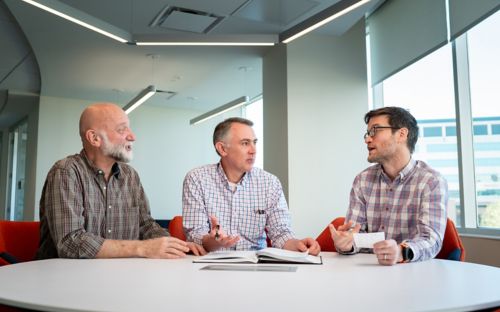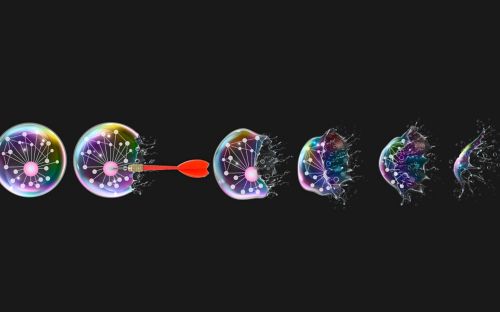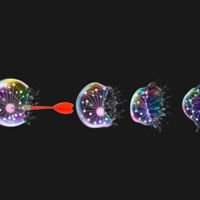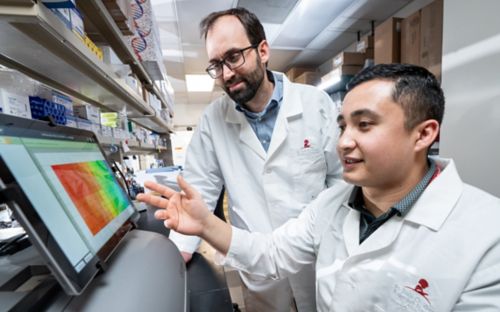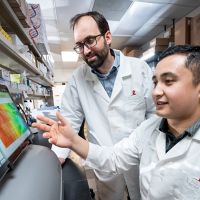Secrets of aggressive, deadly cancers revealed in African yeast
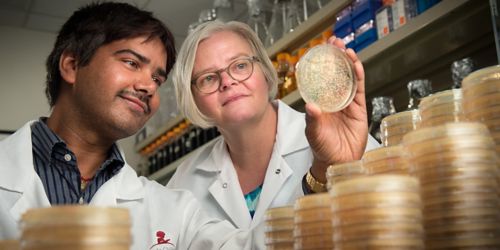
Rajesh Yadav, PhD, postdoctoral research associate, shares results from an experiment with Janet Partridge, PhD, an associate member in the Department of Pathology.
Pediatric high-grade gliomas are deadly. These aggressive brain tumors have resisted surgery, radiotherapy and chemotherapy for years. In fact, fewer than 20 percent of patients survive five years.
There are several mutations in the cancers, and we knew nothing about the biology of one of those mutants. We needed to find out what its effects were. Our lab decided to take a reductionist approach and look into the machinery of the cancer — what happens and why — to get a more detailed understanding of it, and hopefully accelerate progress for finding a way to kill it.
Answers in the yeast
Yeast cells have the same fundamental machinery as humans for managing DNA. Using a yeast called fission yeast, which is great for experiments regarding cellular biology (but rubbish for making bread and beer!), our experiments showed that a mutation frequently found in high-grade glioma tumors triggers a cascade of genomic malfunctions. Our findings were recently published in the scientific journal eLife.
This mutation was unusual. Most cancer-causing genes, when mutated, produce an alternate enzyme that triggers the cancer. This time, the mutation occurred in a gene that is the blueprint for a protein known as a histone. Histones are the “worker bees” in the cell’s machinery for managing DNA. They protect DNA from damage, control when genes switch on or off, and affect how DNA is copied during cell division.
Childhood glioma cells have multiple copies of the histone, with only one copy being defective. For our investigation, we engineered the yeast to only have the mutant histone H3.
H3 handles many cellular functions including cell division and replicating DNA, but it also serves a utility role throughout the cell, doing whatever needs to be done.
Using our mutant yeast, we got to see what the biology of this mutation is.
What we found was fascinating.
The mutation in H3, called G34R, seems subtle, but creates major cellular events as a result. Basically, this mutation hampers the histone’s ability to do its cellular job. Detailed studies showed us that the mutation produced significant effects on how the histone functions. The mutation caused cells to lose chromosomes. Mutant yeast cells had difficulty separating DNA-containing chromosomes after they had been copied, a critical step in dividing cells. The mutant yeast cells were also unable to repair broken DNA strands or overcome the molecular glitches that occur when DNA is copied.
Mapping the machinery
Histone H3 controls similar processes in yeast and mammalian cells. Our hope is that our discoveries will help speed up analysis and treatment of the more complex human gliomas that have both normal and mutant H3.
In addition, our discoveries may help in understanding other cancers arising from histone mutations.
Our findings open the door to further explore the complexities of cancer and this G34R defect in H3. In fact, this mutant histone is found along with mutations in other cancer-causing genes in the childhood gliomas, and we’re not sure how these different mutations work together in the cancer. Figuring that out is the next big challenge.

